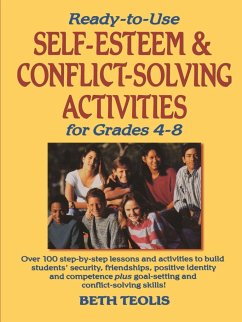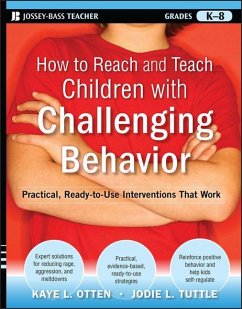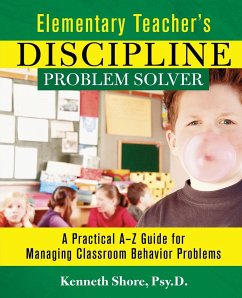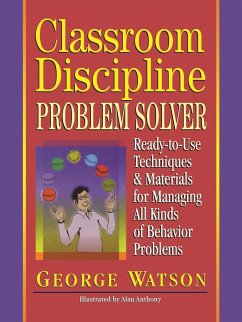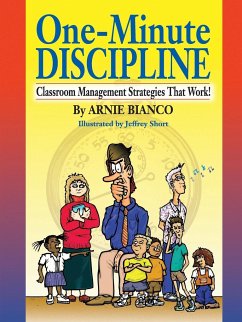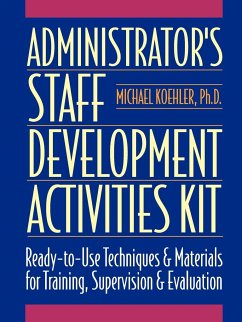
First Class Character Education Activities Program
Ready-To-Use Lessons and Activities for Grades 7 - 12
Versandkostenfrei!
Versandfertig in über 4 Wochen
27,99 €
inkl. MwSt.

PAYBACK Punkte
14 °P sammeln!
This practical resource gives secondary teachers and counselors 95 ready-to-use lessons with reproducible activity sheets to promote healthy character development in secondary students. The activities are drawn from First-Class, one of the most successful character education programs in the country, and can be used as is or adapted to fit the needs in any junior or senior high school. The lessons first focus on defining the nature and aspects of good character and cover a wide range of topics, from behavior in the auditorium and corridors to attitudes regarding a variety of personal and social...
This practical resource gives secondary teachers and counselors 95 ready-to-use lessons with reproducible activity sheets to promote healthy character development in secondary students. The activities are drawn from First-Class, one of the most successful character education programs in the country, and can be used as is or adapted to fit the needs in any junior or senior high school. The lessons first focus on defining the nature and aspects of good character and cover a wide range of topics, from behavior in the auditorium and corridors to attitudes regarding a variety of personal and social issues such as managing anger and stress, and family roles, violence, and the impact of television. For easy use, materials are organized into eight sections and printed in a big 8 1/4" x 11" lay-flat binding for photocopying of the activity pages as many times as needed. Here's just an overview of the lessons/activities in each section: 1. IN THE BEGINNING: Assessing Student Needs ... Identifying the Essentials: Start With Yourself ... Good Character: What Is It? ... The Facets of Good Character 2. STUDENT BEHAVIOR & CHARACTER: First Impressions ... Adult/Student Relationships ... To Be or Not to Be ... It's Cool to Be First-Class ... Guidelines for Appropriate Public Behavior ... Student Evaluation of the Rules ... Student Feedback 3. INTEGRATING SOCIAL PRINCIPLES: Let's Talk Social Principles ... Principles to Build On ... When You Look at My Principles ... To Know or Not to Know (cheating) ... We're in This Together: A Look at Love and Marriage ... Name Your Poison! (drugs) 4. DEALING WITH EMOTIONAL ISSUES: Attitude: It's Your Call ... Stepping Up (facing adversity) ... Failure Is My Friend ... Rejecting Rejection ... Stress ... Handling Anger ... Take Your Pick (right and wrong) ... Handling Anger ... Leadership 5. DEALING WITH SOCIAL ISSUES: Family Roles ... Get It Right (rules of etiquette) ... Gossip ... Peer Pressure ... Positive Interdependence ... Competition vs. Cooperation ... Handling Bullying ...Violence ... Hate ... Let's Take a Closer Look at Television 6. UNDERSTANDING & CELEBRATING DIFFERENCES IN MYSELF: Taking a Closer Look at Me ... Finding the Real Me ... Self-Acceptance ... Self-Criticism ... A Bump on the Way (failure) ... Building a Better Me ... To Get Friends, Be One 7. BEHAVING IN A FIRST-CLASS WAY: The First-Class Pledge ... Bring the Outside In ... Volunteering ... A Teenager's Declaration of Independence ... School Washrooms ... Word Choice ... Considerate Communication ... First Impressions (Appearance) You'll also find a special Epilogue with activities for teachers, whose involvement is critical to the success of the program. These promote ownership, teacher evaluation, and processes for promoting change. In short, First-Class Character Education Activities Program places in you hands a unique store of ready-to-use lessons and activities to help students in grades 7-12 develop character. All have been tested and are equally appropriate for use in homerooms or regular classrooms with students of varying ability.



